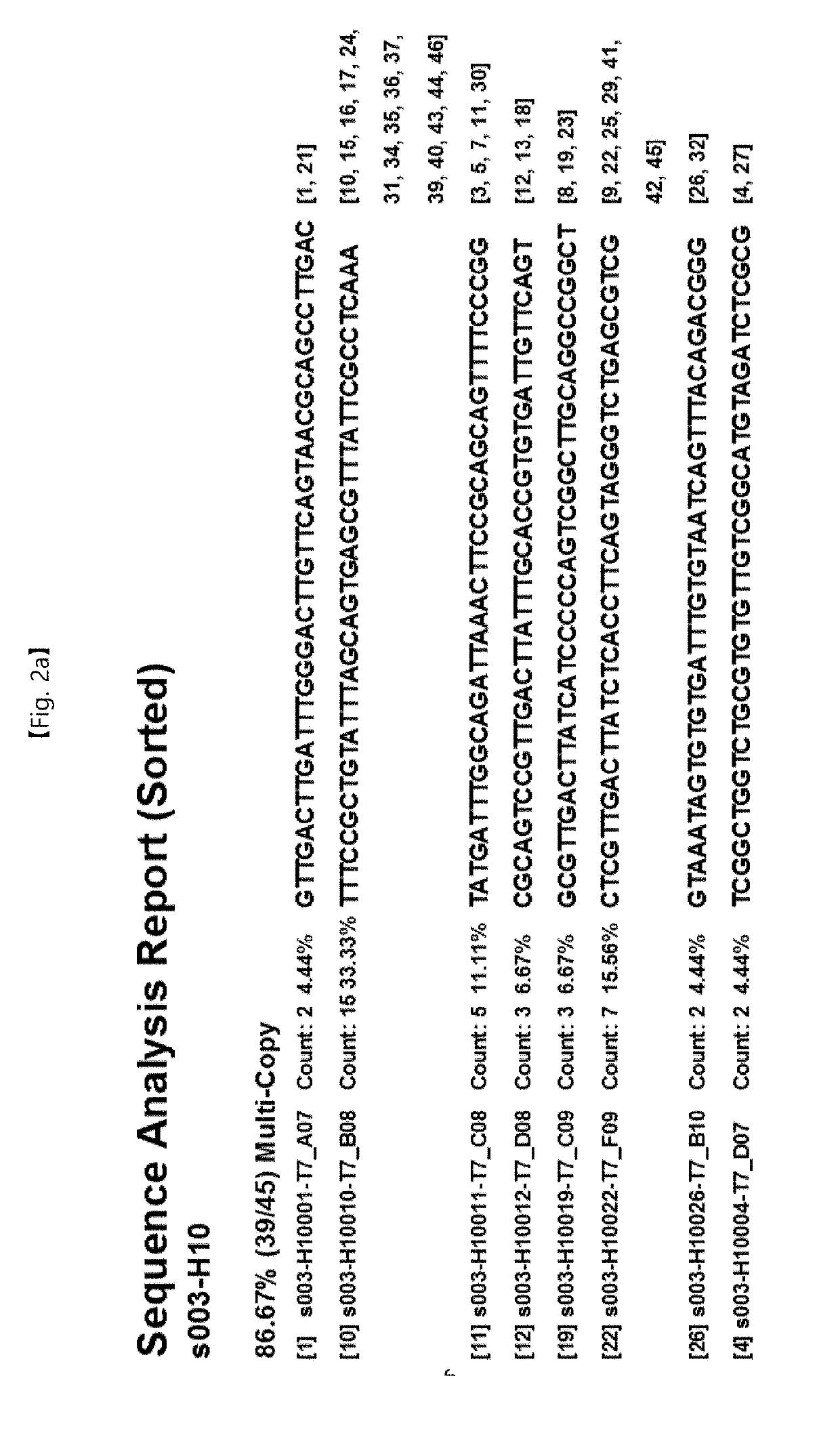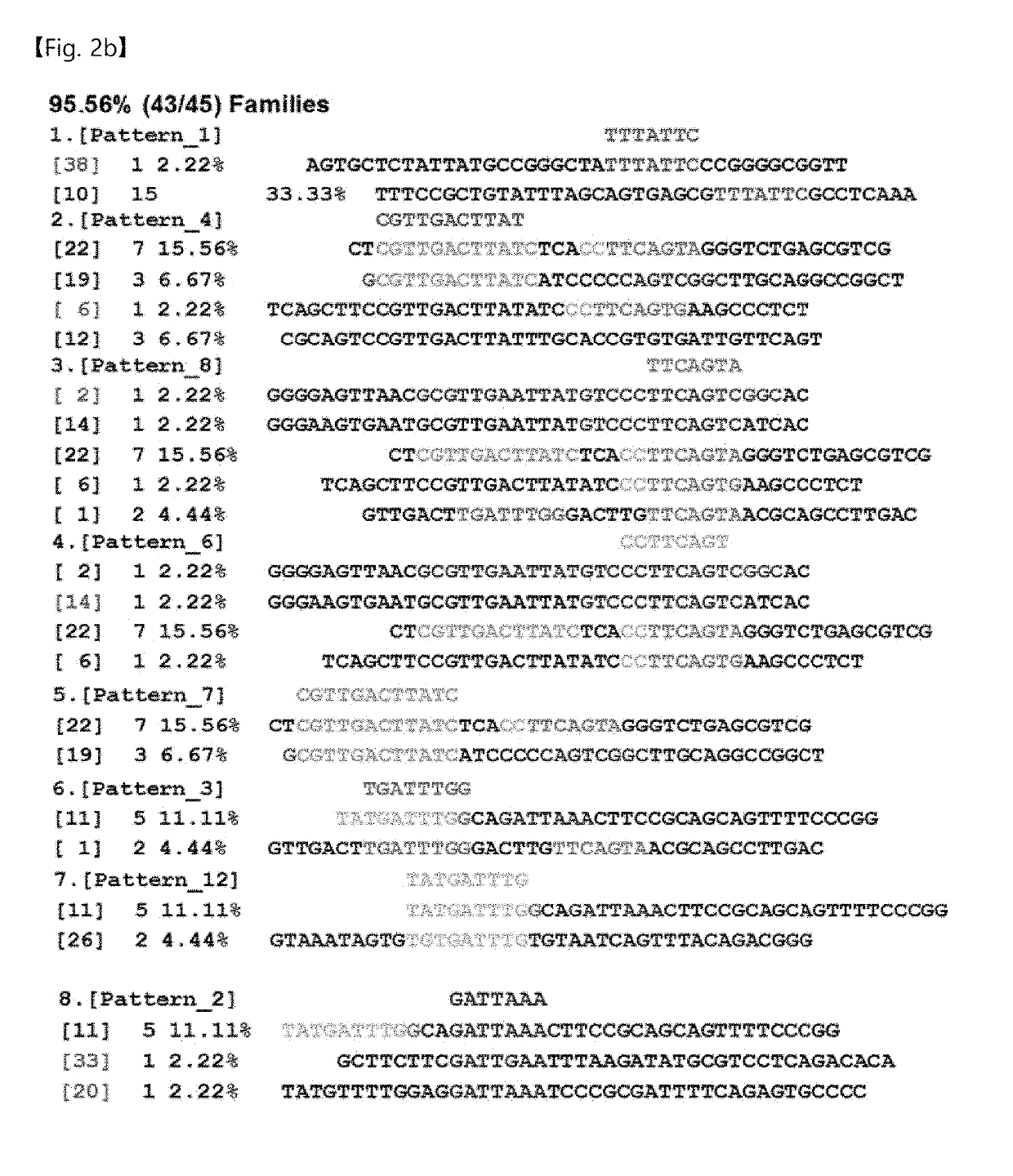Glypican-3 specific aptamer and use thereof
- Summary
- Abstract
- Description
- Claims
- Application Information
AI Technical Summary
Benefits of technology
Problems solved by technology
Method used
Image
Examples
example 1
Discovery of Glypican-3 (GPC3) Specific Binding Aptamer
[0064]1.1 Discovery of Glypican-3 Specific Binding Aptamer through SELEX
[0065]A novel Glypican-3 specific aptamer having selectively high binding activity to Glypican-3 protein was investigated using SELEX (Systematic Evolution of Ligands by Exponential Enrichment) technique after synthesizing 1014 numbers of BzdU library and NapdU library. The process is schematically shown in FIG. 1.
[0066]Aptamers having high binding activity to GPC3 was screened by analyzing sequences of candidate aptamers found by the discovery process and classifying into multi-copy, family 14 kinds as a result of the primary SELEX and 30 kinds as a result of the secondary SELEX were discovered. Sequence analysis results of discovered aptamers were shown in FIGS. 2a and 2b (primary SELEX, the above table 1) and FIGS. 2c to 2f (secondary SELEX, the above table 2).
[0067]1.2 Evaluation of Binding Activity of Discovered Aptamers
[0068]The binding activity of apt...
example 2
Evaluation of in Vitro Efficacy of Glypican-3 (GPC3) Specific Binding Aptamer
[0070]2.1 Confirmation of Selective Binding Activity of GPC3 Aptamer in a Hepatocellular Carcinoma Cell Line Using FACS Method
[0071]The binding activity of FITC-labeled GPC3 aptamers (primary SELEX 14 kinds, secondary SELEX 30 kinds) to a hepatocellular carcinoma cell line was confirmed using FACS method. The binding activity to a normal hepatic stellate cell line LX-2 and hepatocellular carcinoma cell lines Huh-7, SNU761, SNU475, SH3, H17 was confirmed, and the GPC3 aptamer showing high binding activity to the hepatocellular carcinoma cell lines was screened. The result of measuring the binding activity was shown in FIG. 5a and FIG. 5b.
[0072]2.2 Evaluation of Efficacy of Inhibiting Proliferation of Hepatocellular Carcinomas of GPC3 Aptamers using MTS Assay
[0073]An efficacy of inhibiting proliferation of hepatocellular carcinomas of GPC3 aptamers was verified using a cell viability assay, MTS assay. As a r...
example 3
Mechanism of Glypican-3(GPC3) Specific Binding Aptamer
[0075]After treating 2 kinds of GPC3 aptamers (SEQ ID NOs: 3 and 11) that their efficacy of inhibiting proliferation of hepatocellular carcinomas was confirmed to a hepatocellular carcinoma cell line, a signaling route related to proliferation and apoptosis of hepatocellular carcinoma cells, etc. was confirmed using immunoblotting. The result was shown in FIG. 8, and it was confirmed that a signal involving in cell survival and proliferation processes, erk1 / 2 expression was decreased after treatment of GPC3 aptamers, but it was confirmed that a caspase route inducing apoptosis was not activated. Therefore, it was expected that GPC3 aptamers would show an effect on inhibition of proliferation rather than direct induction of hepatocellular carcinoma cell death.
[0076]In addition, the result of confirming expression of Yap protein which was known as an intracellular downstream signal of a hepatocellular carcinoma specific membrane pr...
PUM
| Property | Measurement | Unit |
|---|---|---|
| Dissociation constant | aaaaa | aaaaa |
| Hydrophobicity | aaaaa | aaaaa |
| Fluorescence | aaaaa | aaaaa |
Abstract
Description
Claims
Application Information
 Login to View More
Login to View More - R&D
- Intellectual Property
- Life Sciences
- Materials
- Tech Scout
- Unparalleled Data Quality
- Higher Quality Content
- 60% Fewer Hallucinations
Browse by: Latest US Patents, China's latest patents, Technical Efficacy Thesaurus, Application Domain, Technology Topic, Popular Technical Reports.
© 2025 PatSnap. All rights reserved.Legal|Privacy policy|Modern Slavery Act Transparency Statement|Sitemap|About US| Contact US: help@patsnap.com



